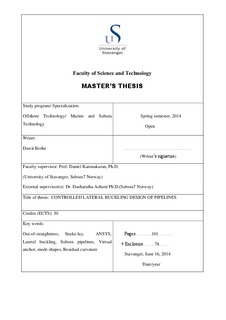| dc.contributor.author | Berhe, Dawit | |
| dc.date.accessioned | 2014-09-12T13:22:52Z | |
| dc.date.available | 2014-09-12T13:22:52Z | |
| dc.date.issued | 2014-06-16 | |
| dc.identifier.uri | http://hdl.handle.net/11250/219667 | |
| dc.description | Master's thesis in Offshore technology | nb_NO |
| dc.description.abstract | Constrained high temperature and pressure pipelines (HPHT) are subjected to global buckling due to plane strain condition developed by virtual anchorage of soil friction resistance and subsea facilities. Any uncontrolled lateral buckling is a potential hazard for a pipeline’s structural integrity, especially when whole compressive force is released at one point and excessive feed-in occurs.
The cost effective and elegant design solution is to work with the pipeline by letting it buckle in a controlled fashion and relieve some axial compressive force rather than trying to avoid buckling completely. There exist a number of mitigation methods which will allow the pipeline to buckle in a controlled manner. Snake-lay and residual curvature lay methods are such methods to initiate controlled buckling and are considered in the present thesis work.
The objective of the current work has been to design the selected pipelines under controlled lateral buckling by applying the above mentioned methods combined with trawl gear interaction. The selected pipelines for the work are 22” pipeline for snake-lay and 14” pipeline for residual curvature lay. The buckle initiation configurations were established based on the maximum allowable design feed-in into the buckle. The allowable design feed-ins of the selected pipelines were determined based on FE (Finite Element) analyses by modelling the pipes with given OOS (Out-of-Straightness) radii of the selected methods and combining trawl pull-over loads. The basis for estimation of the maximum allowable design feed-in is the pipeline capacity which was calculated based on the design criteria from DNV-OS-F110. In the current work, both load controlled and displacement controlled criteria have been considered for the analyses.
The work has been carried out by performing non-linear finite element analysis using a software ANSYS. The analyses include geometric and material non-linearities along with the pipe-soil interaction. The results based on both the analytical calculations and the FE analyses are presented and discussed against the relevant allowable design limiting criteria from DNV-OS-F101and DNV-RP-F110.
The results from the analyses show that trawl interaction with subsea pipelines has a significant influence on the pipeline design when it is combined with the selected buckle initiation methods. The increase in rock volume is significant as the allowable feed-ins get reduced. | nb_NO |
| dc.language.iso | eng | nb_NO |
| dc.publisher | University of Stavanger, Norway | nb_NO |
| dc.relation.ispartofseries | Masteroppgave/UIS-TN-IKM/2014; | |
| dc.subject | out-of -straightness | nb_NO |
| dc.subject | snake-lay | nb_NO |
| dc.subject | ANSYS | nb_NO |
| dc.subject | lateral buckling | nb_NO |
| dc.subject | subsea pipelines | nb_NO |
| dc.subject | virtual anchor | nb_NO |
| dc.subject | residual curvature | nb_NO |
| dc.subject | offshore teknologi | nb_NO |
| dc.subject | undervannsteknologi | nb_NO |
| dc.title | Controlled lateral buckling design of pipelines | nb_NO |
| dc.type | Master thesis | nb_NO |
| dc.subject.nsi | VDP::Technology: 500::Marine technology: 580::Offshore technology: 581 | nb_NO |
| dc.source.pagenumber | 101+78 | nb_NO |
